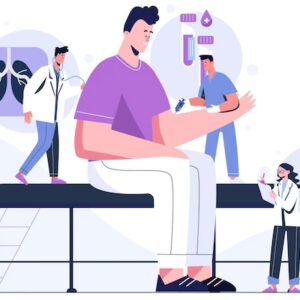World Cancer Day 2020: Awareness of Cancer and its prevention
World Cancer Day 2020: Awareness of Cancer and its prevention. World Cancer Day is observed on 4th February consistently to make mindfulness about malignancy. The theme 2019-2021 is ‘I am and I will’.
Cancer occurs due to the uncontrolled, irregular development of cells in the tissue or organ of the body. Malignancy can happen at any age and if not identified early and treated, it very well may be lethal. It is the subsequent driving reason for death all around.
World Cancer Day intends to save a huge number of preventable deaths every year by bringing awareness and education about malignant growth and squeezing governments and people over the world to make a move against the ailment.
Most Common Cancers in India:
- Lung cancer
- Breast cancer
- Cervical cancer
- Colorectal cancer
World Cancer Day 2020: Awareness of Cancer and its prevention.
All about Lung Cancer:
What is Lung Cancer?
The lungs are a couple of sponge-like cone-formed organs in the chest. These are a piece of our respiratory structure. The left lung is littler in light of the fact that the heart consumes space on the left side.
The lungs are somewhat unique in relation to one another; the Right lung has three projections, while the left one has two flaps.
They are secured by a slight covering called ‘pleura’ which secures and enables the lungs to move to and fro as they extend and contract during relaxing.
The principle capacity of the lungs is to trade gases between the air we inhale and the blood. At the point when we take in (breath in), oxygen goes into the body through the lungs and when we inhale out (breathe out) carbon dioxide is conveyed of the body.
Air enters the lungs through the nose or mouth by means of the windpipe (trachea) which separates into two aviation routes going into the privilege and left lung each. These aviation routes are called ‘bronchi (particular, bronchus).
Lung malignant growth starts from the tissues of the lung, generally from cells coating the air entries. The two primary sorts are Small cell lung malignant growth (SCLC) and non-small cell lung disease (NSCLC).
These sorts are analyzed dependent on how the cells look under a magnifying lens. Over 80% of all lung malignant growths have a place with the non-little cell type.
The 3 significant subtypes of non-small cell lung disease growth are adenocarcinoma, squamous cell carcinoma, and huge cell carcinoma.
It is the second most regular disease in men and the fifth most normal malignancy in the both men and women together.
It can spread too far off pieces of the body through the blood and lymphatic vessels. This is called metastasis.
World Cancer Day 2020: Awareness of Cancer and its prevention.
Risk factors you can change to prevent yourself from cancer:
- Tobacco Use: Cigarette and beedi smoking is the number one hazard factor for lung malignancy. Smokeless tobacco use is furthermore connected with tumors of the lip, oral pit, pharynx, stomach related, respiratory and intrathoracic organs. The harmful synthetic compounds in tobacco harm the cells in the lungs.
- Asbestos: Asbestos is delegated a known human cancer-causing agent and has been straightforwardly and logically connected to lung malignant growth and other respiratory conditions Asbestos is a lot of six normally happening strong mineral generally utilized in house development materials, autos parts and materials because of its amazingly tough and heatproof. Asbestos filaments are minuscule in nature and when breathed in, get held up in the delicate inward tissue of the respiratory framework and can bother the lungs. There is no sheltered level or no protected sort of asbestos.
- Occupational presentation to substance cancer-causing agents: Workplace introduction to arsenic, chromium, diesel fumes, silica, and nickel can likewise build the danger of creating lung malignant growth and it is higher for the individuals who additionally smoke.
- Radon: Exposure to radon has been related to an expanded danger of certain kinds of cancerous growth, including lung disease. Radon is undetectable, smell-less gas discharged normally from the earth and shakes by the breakdown of uranium that gets blended in with the air we inhale in the long run. In this way, individuals who invest a lot of their energy in storm cellar rooms at home or at work have a more serious hazard for being uncovered.
- Indoor consuming of coal: There is adequate proof that indoor ignition of coal, either for cooking or warming, builds the danger of lung malignancy. In inadequately ventilated houses, cooking or warming with coal on open flames in conventional stoves brings about significant levels of indoor air contamination because of a wide scope of toxins that harm wellbeing.
- Infections in the lung: Having had contaminations like chlamydia pneumonia or illness like tuberculosis (TB) that can prompt scar tissue development in the lungs may have an expanded hazard for adenocarcinoma of the lung, a kind of lung malignancy.
- Diet: Evidence proposes that some dietary components might be defensive for lung malignant growth and some may build the danger of lung disease. People with the low admission of nourishments rich in beta-carotene, for example, carrots, have a higher risk for lung disease
- Family/Personal History of Lung Cancer: People with a family ancestry of lung disease in first-degree family members have an expanded danger of lung malignant growth. The hazard might be higher if there is a positive family ancestry since they share a similar living space, There is a danger of creating lung malignant growth in the other lung, in the event that you have had lung disease on the opposite side.
How can it be prevented?
There is no demonstrated method to prevent lung malignancy, yet there are steps to bring down the danger of getting lung disease. You can help bring down your danger of getting lung disease in the accompanying manners:
- Stop Smoking
- Maintain a strategic distance from recycled smoke
- Lower your exposure to radon
- Lower exposure to work environment chance elements
- Diet wealthy in foods grown from the ground
- Regular physical action
World Cancer Day 2020: Awareness of Cancer and its prevention.
All about Breast Cancer:
What is Breast Cancer?
Breast Cancer is the harmful tumor (a tumor with the possibility to attack different tissues or spread to different pieces of the body) that starts in the cells of the breast. It happens both in Men and Women. Anyway male breast cancerous growth is rare.
Is it right to say that you are in danger?
A risk factor for breast disease is whatever expands your chance of getting breast cancerous growth.
Having a hazard factor doesn’t imply that you will create breast malignancy.
- Sexual orientation: If you are a lady, you are having higher chance to create breast malignant growth than men. This might be because of more introduction to hormones which advance breast cell development, (for example, estrogen and progesterone).
- Age: Your risk of bosom cancerous growth increases as you age. An examination in North India detailed that the normal age of the patient at introduction was somewhere in the range of 45 and 50 years.
- Family ancestry of malignant growth: Your danger of bosom disease increments, if your mom, sister or daughter was determined to have breast disease, especially at a youthful age. Your risk likewise increments if your dad or sibling had bosom malignant growth.
- Hereditary Factors: If you have acquired certain uncommon quality changes from guardians, you are at an expanded hazard for breast malignancy. The most widely recognized known quality changes saw in individuals with breast tumors are in the BRCA1 and BRCA2 qualities. Having these transformed qualities doesn’t imply that you will get bosom malignant growth. Breast malignancies connected to BRCA1 and BRCA2 transformations happen all the more much of the time in more youthful ladies and all the more regularly influence the two bosoms contrasted with tumors that are not connected to these changes. Ladies with these acquired transformations likewise have an expanded hazard for creating ovarian malignant growths. Hereditary tests are accessible to search for these freak qualities that are connected with bosom malignant growth. Hereditary tests are not prescribed for everybody. You ought to talk about with your primary care physician if these hereditary tests are useful for your situation.
- Previous history of breast malignant growth: If you have had breast disease prior, you have an expanded danger of creating disease in the other bosom.
- Weight: Being heavy builds your danger of bosom malignancy.
- Pregnancy : Women who have never been pregnant have a more danger of bosom disease than ladies who have had at least one pregnancies. Additionally, bringing forth a child after the age 35 may expand the danger of bosom malignant growth contrasted with ladies who conceive an offspring prior.
- Lactation: Lack of or shorter span of lactation expands the danger of breast malignant growth.
- Drinking liquor: Drinking extreme liquor expands the danger of breast malignant growth.
- Hormone consumption: Women treated to get help from menopausal side effects with joined estrogen and progesterone hormone treatment prescriptions (hormone substitution treatment) have an expanded danger of breast malignancy.
- Radiation presentation: Moderate to high-portions of introduction to ionizing radiation presentation or getting radiation treatment to your chest zone as a youngster or youthful grown-up, expands the danger of breast malignancy.
- Menstrual History: Having your first period at a more youthful age (before age 12) expands your danger of breast malignant growth. In like manner achieving menopause at a more established age expands your hazard.
How can it might be prevented?
- Avoidance by evolving way of life-related hazard factors
- Keep up perfect body weight
- Exercise normally
- Stop smoking and unreasonable liquor utilization
- Bosom feed the infant
- Maintain a strategic distance from pointless radiation presentation.
World Cancer Day 2020: Awareness of Cancer and its prevention.
All about Cervical Cancer:
What is Cervical Cancer?
The cervix is the lower some portion of the belly otherwise called uterine cervix.
The piece of the cervix nearest to the body of the uterus is known as the endocervix. The part alongside the vagina is the ectocervix. The cervix is around 2-3 cms long.
More ladies in India pass on from cervical malignancy than in some other nation. Cervical malignant growth is the second most normal disease among Indian ladies.
Cervical malignant growth is a preventable infection as it has an all-around characterized, long pre-threatening stage which can be recognized by common screening tests and development. Shockingly, most ladies in India don’t know about the screening.
Are you at risk?
• Persevering contamination of the cervix with Human Papillomavirus (HPV)
• Having numerous sexual partners
• Spouse having numerous sexual partners
• Having first sex at a young age
• Giving Birth to numerous children
How might it be prevented?
• Embrace safe sex rehearses (maintain a strategic distance from numerous sexual accomplices).
• Utilization of male condoms as boundary contraceptives to lessen the danger of HPV contamination.
• Auspicious treatment of conceptive tract contaminations.
World Cancer Day 2020: Awareness of Cancer and its prevention.
All about Colorectal Cancer:
What is colorectal cancer?
Colorectal cancerous growth is the disease of the colon or maybe rectum which starts with the improvement of pre-harmful polyps from the covering of the colon and rectum.
These malignant growths can likewise be named colon disease or rectal disease, contingent upon where they start.
Colon malignant growth and rectal disease are frequently gathered on the grounds that they share numerous highlights for all intents and purposes.
Are you at Risk?
Hazard factors you can’t change (non-modifiable hazard factors)
- Age: Your risk gets higher as you get older. More youthful grown-ups may likewise create colorectal malignancy yet the odds increment particularly after you turn 50.
- The individual history of colorectal polyps or colorectal malignancy: If you have a past filled with particular sorts of polyps known as adenomatous polyps (adenomas), you are at an expanded danger of creating colorectal disease. This is particularly valid if the polyps are enormous or on the off chance that they are more in number.
- On the off chance that you have had the colorectal disease before, you are progressively inclined to grow new malignant growths in different zones of the colon and rectum regardless of whether the past malignant growth was totally expelled. The odds are more noteworthy on the off chance that you had your first colorectal malignancy at a more youthful age.
- An individual history of incendiary gut ailment (IBD): Having a past filled with ulcerative colitis or Crohn’s sickness ( sorts of fiery inside maladies) expands your danger of creating colorectal malignant growth. In the event that you have IBD, you may need to begin being screened normally for colorectal malignancy from a more youthful age.
- Family ancestry of colorectal malignant growth: If you have a background marked by colorectal disease in a first-degree relative (parent, kin, or kid) you are at expanded hazard. The hazard is much higher if that relative created malignancy at an age more youthful than 45, or if more than one first-degree relative was influenced.
- Race or ethnic foundation: being of African American or Ashkenazi builds your hazard.
- Acquired disorders that expand colon disease hazard: Certain hereditary disorders went through ages of your family can expand your danger of colon malignant growth. These disorders incorporate familial adenomatous polyposis and genetic nonpolyposis colorectal malignant growth (otherwise called Lynch disorder).
Hazard factors you can change (Modifiable hazard factors)
- Weight. In the event that you are hefty, you have an expanded danger of colon disease and an expanded danger of creating colon malignant growth.
- Smoking. On the off chance that you who have smoked cigarettes for quite a while you are bound to create and kick the bucket from the colorectal disease.
- Type 2 diabetes: If you have diabetes and insulin opposition may have an expanded danger of colon disease.
- Liquor. Substantial utilization of liquor may expand your danger of colon malignancy
- A stationary way of life. In the event that you lead a latent life, you are bound to create colon malignant growth.
- Specific kinds of diets: Consumption of diet wealthy in red meats and handled meats can expand your hazard for colorectal malignant growth.
- Radiation treatment for the disease. Radiation treatment guided at the mid-region to treat past malignant growths may expand your danger of colon disease
How can it be prevented?
There’s no certain method to prevent colorectal malignant growth. Be that as it may, there are things you can do that may help bring down your hazard, for example, reducing the hazard factors that you can control:
• Living at a healthy weight and keeping away from weight gain.
• Expanding the power and measure of your physical activity.
• Restricting read and handled meats and eating more vegetables and natural products
• Avoiding excess liquor.
• Stopping smoking.
• Ordinary screening might be attempted for people at high hazard. This can distinguish polyps which can be expelled before they get the opportunity to return into malignancy.
-
Sale!

Executive Health Check Up
Original price was: ₹ 4,940.00.₹ 1,999.00Current price is: ₹ 1,999.00. ADD TO CART -
Sale!

Express Health Check Up
Original price was: ₹ 11,760.00.₹ 4,699.00Current price is: ₹ 4,699.00. ADD TO CART -

Express Pro Health + +
₹ 4,899.00 ADD TO CART -

Express Pro Health Basic
₹ 1,999.00 ADD TO CART -

Express Pro Health Comprehensive
₹ 20,999.00 ADD TO CART This product has multiple variants. The options may be chosen on the product page -
Sale!

Full Body Check Up
Original price was: ₹ 18,335.00.₹ 6,999.00Current price is: ₹ 6,999.00. ADD TO CART -
Sale!

Master Health Check Up
Original price was: ₹ 7,070.00.₹ 2,999.00Current price is: ₹ 2,999.00. ADD TO CART -
Sale!

Preventive Health Check Up
Original price was: ₹ 2,720.00.₹ 999.00Current price is: ₹ 999.00. ADD TO CART -
Sale!

Senior Citizen Health Check Up
Original price was: ₹ 9,800.00.₹ 3,599.00Current price is: ₹ 3,599.00. ADD TO CART -
Sale!

Smart Women Package
Original price was: ₹ 8,800.00.₹ 3,999.00Current price is: ₹ 3,999.00. ADD TO CART
Locations:
Kalyani Nagar, Pune:
Ground Floor, B1 Building, Cerebrum IT Park, Behind Marigold Society, Kalyani Nagar, Pune 411014
Chinchwad, Pune:
Shop no 18/19/20, L3 Building, Empire Estate, Chinchwad, Pune – 411019
Satara Road, Pune:
Shop No – 110 – 111, Pentagon Building, Shahu College Road, Next to Kaka Halwai, Satara Road, Pune – 411009
Magarpatta A Wing, Pune:
S -10, 2nd Floor, A – wing Destination Centre, Magarpatta, Hadapsar, Pune – 411013
Pimple Saudagar, Pune:
Shop No-203, 2nd Floor, Rainbow Plaza, Near Shivar Garden Chowk, Pimple Saudagar, Pune – 411057
Viman Nagar, Pune:
Row House No-2, Plot No – 88, Wing F, Nitron Landmark, Vimannagar, Pune-14
Moshi, Pune
Toll-Free Number: 1800 267 9191
Email: info@expressclinics.in
Get in Touch With Express Clinics, Mumbai:
Toll-Free Number: 1800 267 9191
Email: info@expressclinics.in
Get in Touch With Express Clinics, Navi Mumbai:
Toll-Free Number: 1800 267 9191
Email: info@expressclinics.in
Get in Touch With Express Clinics, Thane:
Toll-Free Number: 1800 267 9191
Email: info@expressclinics.in
Get in Touch With Express Clinics, Delhi:
Toll-Free Number: 1800 267 9191
Email: info@expressclinics.in
Get in Touch With Express Clinics, Noida:
Toll-Free Number: 1800 267 9191
Email: info@expressclinics.in
Get in Touch With Express Clinics, Gurugram:
Toll-Free Number: 1800 267 9191
Email: info@expressclinics.in
Get in Touch With Express Clinics, Bengaluru:
Toll-Free Number: 1800 267 9191
Email: info@expressclinics.in
Get in Touch With Express Clinics, Chennai:
Toll-Free Number: 1800 267 9191
Email: info@expressclinics.in
Get in Touch With Express Clinics, Goa:
Toll-Free Number: 1800 267 9191
Email: info@expressclinics.in
Get in Touch With Express Clinics, Hyderabad:
Toll-Free Number: 1800 267 9191
Email: info@expressclinics.in
Get in Touch With Express Clinics, Ahmedabad:
Toll-Free Number: 1800 267 9191
Email: info@expressclinics.in
Get in Touch With Express Clinics, Vadodara:
Toll-Free Number: 1800 267 9191
Email: info@expressclinics.in
Get in Touch With Express Clinics, Surat:
Toll-Free Number: 1800 267 9191
Email: info@expressclinics.in
Get in Touch With Express Clinics, Lucknow:
Toll-Free Number: 1800 267 9191
Email: info@expressclinics.in
Get in Touch With Express Clinics, Cochin:
Toll-Free Number: 1800 267 9191
Email: info@expressclinics.in
Get in Touch With Express Clinics, Bhopal:
Toll-Free Number: 1800 267 9191
Email: info@expressclinics.in
Get in Touch With Express Clinics, Indore:
Toll-Free Number: 1800 267 9191
Email: info@expressclinics.in
Get in Touch With Express Clinics, Jaipur:
Toll-Free Number: 1800 267 9191
Email: info@expressclinics.in
Get in Touch With Express Clinics, Nagpur:
Toll-Free Number: 1800 267 9191
Email: info@expressclinics.in
Get in Touch With Express Clinics, Nashik:
Toll-Free Number: 1800 267 9191
Email: info@expressclinics.in

